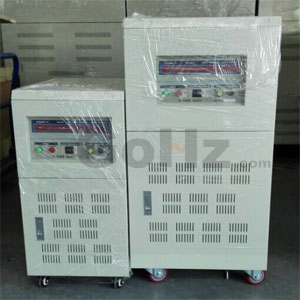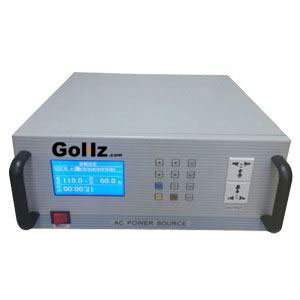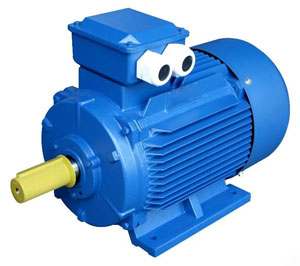Can a 240v appliance work on 120v in US?
Nearly all residential appliances are single phase devices and are connected to a center-tapped 240V single phase transformer winding. With respect to the center tap (neutral), there are two phases - one at each end of the winding. The two phases have equal magnitudes (120V) and opposite angles: 0-deg and 180-degrees.
Residential power in the US is usually provided by the center tapped secondary of a distribution transformer. Two wires are hot, 120V at 180 degrees out of phase therefore 240V when used together. For 120V there is another neutral wire. Connecting either hot wire and the neutral provides 120V. This is how most modern US homes are wired. The 240V is used only for high wattage appliances like clothes dryers or water heaters.
If the Appliance have two hot, neutral and ground you will need a transformer that input 1P 240V and have an output 120V-0-120V for it to work. The neutral is connected to the 0v terminal and the two hot connected to 120v terminals. I have used this for a dryer that came from the Canada and a Cooker that came from the US. I did this in Grenada where the supply Voltage is 230V single phase and it works. Just using the three wire L-N-E does not work. So it would be L1-L2-N-E. Most times it is Red-Black-White-Green
Household appliances, like air conditioners/dryers/ranges/ovens, use 120V/240V with neutral and ground. Always review the machine wiring diagram. It may be using 120V to step down to 24V for control circuits. Also, how the heaters (in case of dryer/range/ovens) are connected inside the machine. In this case, alone 240V will not work. It helps to know the machine wiring diagram for correct power connections.
There is nothing magic about three phase. Almost all power systems all over the world generate three-phase high voltage electricity at 50 or 60 Hz. For home or business use, many appliances and machines are single phase at 120 or 240 volts, using one phase of the three phase system. Large machinery uses three phase at 240 or a higher voltage. A variable speed drive with a 208Y/120 output could be used to operate 120v equipment but it would be "overkill" unless you had several appliances and kept the phases balanced with about the same load.
Residential power in the US is usually provided by the center tapped secondary of a distribution transformer. Two wires are hot, 120V at 180 degrees out of phase therefore 240V when used together. For 120V there is another neutral wire. Connecting either hot wire and the neutral provides 120V. This is how most modern US homes are wired. The 240V is used only for high wattage appliances like clothes dryers or water heaters.
If the Appliance have two hot, neutral and ground you will need a transformer that input 1P 240V and have an output 120V-0-120V for it to work. The neutral is connected to the 0v terminal and the two hot connected to 120v terminals. I have used this for a dryer that came from the Canada and a Cooker that came from the US. I did this in Grenada where the supply Voltage is 230V single phase and it works. Just using the three wire L-N-E does not work. So it would be L1-L2-N-E. Most times it is Red-Black-White-Green
Household appliances, like air conditioners/dryers/ranges/ovens, use 120V/240V with neutral and ground. Always review the machine wiring diagram. It may be using 120V to step down to 24V for control circuits. Also, how the heaters (in case of dryer/range/ovens) are connected inside the machine. In this case, alone 240V will not work. It helps to know the machine wiring diagram for correct power connections.
There is nothing magic about three phase. Almost all power systems all over the world generate three-phase high voltage electricity at 50 or 60 Hz. For home or business use, many appliances and machines are single phase at 120 or 240 volts, using one phase of the three phase system. Large machinery uses three phase at 240 or a higher voltage. A variable speed drive with a 208Y/120 output could be used to operate 120v equipment but it would be "overkill" unless you had several appliances and kept the phases balanced with about the same load.
Will a 220v UK single-phase countertop burner be OK in a Canadian 240v 2-phase outlet?
Hi there!
Thank you for the article. I had difficulty understanding some pieces. In my case, I am moving to a new apartment w/o 240V outlet and no ability to wire for one. How could I bring an cooking appliance that runs on 240V and uses a 6 kW immersion heater element.
Here are specs. from the website:
"30 Amp @ 240 V single phase (normal residential)
15 1/4" insertion length
Incoloy (804 stainless steel) elements
Nema 1 enclosure
2" Tri-Clover compatible connection
Thermowell in element."
Are there any options to circumvent not having a compatible outlet available -- or is this an piece of equipment ill likely need to sell off or give away?
Thanks for your time and hope to hear your opinions.
A.B.
Thank you for the article. I had difficulty understanding some pieces. In my case, I am moving to a new apartment w/o 240V outlet and no ability to wire for one. How could I bring an cooking appliance that runs on 240V and uses a 6 kW immersion heater element.
Here are specs. from the website:
"30 Amp @ 240 V single phase (normal residential)
15 1/4" insertion length
Incoloy (804 stainless steel) elements
Nema 1 enclosure
2" Tri-Clover compatible connection
Thermowell in element."
Are there any options to circumvent not having a compatible outlet available -- or is this an piece of equipment ill likely need to sell off or give away?
Thanks for your time and hope to hear your opinions.
A.B.
Post a Comment:
You may also like:
50Hz 60Hz Frequency Converter Setting
Using GoHz frequency converter to
Or customize your own converters.
- Convert 220v 50Hz to 110v 60Hz,
- Convert 120v 60Hz to 230v 50Hz,
- Convert 110v 60Hz to 240v 50Hz,
- Convert 480v 60Hz to 380v 50Hz,
- Convert 400v 50Hz to 460v 60Hz,
- Convert 240v 60Hz to 380v 50Hz,
Or customize your own converters.
Featured Articles
460v 60Hz motor on 400v 50Hz power ...
 Often the European motors at 1hp size are universal for 50Hz or 60Hz power supply, as long as you have 400V x 50Hz and 460V x ...
Often the European motors at 1hp size are universal for 50Hz or 60Hz power supply, as long as you have 400V x 50Hz and 460V x ...
 Often the European motors at 1hp size are universal for 50Hz or 60Hz power supply, as long as you have 400V x 50Hz and 460V x ...
Often the European motors at 1hp size are universal for 50Hz or 60Hz power supply, as long as you have 400V x 50Hz and 460V x ...Convert 220v, 230v, 240v 50Hz to 110v, ...
 When you buy an 110v (120v) 60Hz appliance from USA, and run it on 220v (230v, 240v) 50Hz country (i.e. UK, Australia, ...
When you buy an 110v (120v) 60Hz appliance from USA, and run it on 220v (230v, 240v) 50Hz country (i.e. UK, Australia, ...
 When you buy an 110v (120v) 60Hz appliance from USA, and run it on 220v (230v, 240v) 50Hz country (i.e. UK, Australia, ...
When you buy an 110v (120v) 60Hz appliance from USA, and run it on 220v (230v, 240v) 50Hz country (i.e. UK, Australia, ...60Hz motor running on 50Hz power ...
 Electric motors, both single and three phase, are designed for running on a specified power frequency. But sometimes we may use a ...
Electric motors, both single and three phase, are designed for running on a specified power frequency. But sometimes we may use a ...
 Electric motors, both single and three phase, are designed for running on a specified power frequency. But sometimes we may use a ...
Electric motors, both single and three phase, are designed for running on a specified power frequency. But sometimes we may use a ...